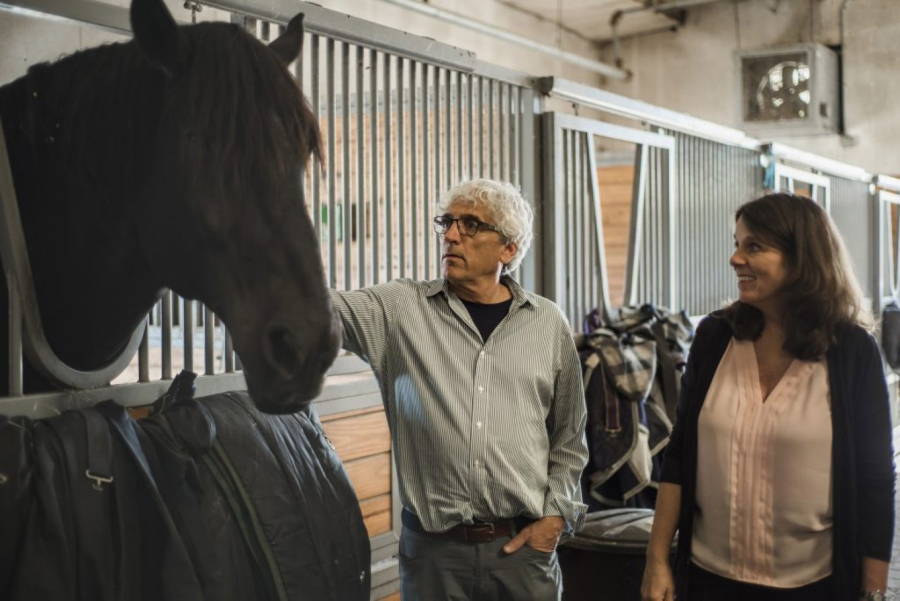If a horse lets you pick its foot up off the ground, that’s a big deal. The action destabilizes the horse, so allowing someone to hold its foot means the horse believes the person means no harm.
At the Bergen Equestrian Center in Leonia, N. J., that sort of trust-building exercise isn’t just for the four-legged. A team of Columbia University researchers there is taking an unusual approach to treating post-traumatic stress disorder, by having veterans spend time with horses.
As it turns out, these people and animals have some important commonalities.
“Horses, by nature, they’re sort of prey animals, and so they’re hyper-vigilant and reactive to people’s behavior,” said Prudence Fisher, a professor of clinical psychiatric social work at Columbia, who has been co-directing the study for the past year. “If you approach them aggressively they’ll move away from you. So it helps people recognize how they’re approaching people.”
In the study, three or four veterans at a time spend 90 minutes with two horses and two staff members once a week for eight weeks, slowly learning to interact with and become comfortable with the animals and learning about themselves through them.
“The veterans feel that the horses are mirroring what they feel,” said Yuval Neria, a medical psychology professor at Columbia and the study’s other director. At the outset, “Both the horses and the vets kind of exhibit or even suffer from the same fear circuit-based behavior. They are both fearful, initially, they are both apprehensive, initially, they avoid being together initially, and over time they develop the ability to be together.”
The idea is to address PTSD, a signature disorder among veterans which has a host of emotional symptoms, from angry outbursts to difficulty sleeping to trouble concentrating to avoidance of trauma-related triggers. Pharmacological and traditional talk therapy are not always effective, so alternative approaches are on the rise.
The Columbia study will continue through the end of the year, by which time the researchers expect 50 to 60 veterans will have come through. They would not release results mid-trial, but they said that what they have seen so far has been promising.
“There’s a lot about trust, about being clear with your intentions,” Fisher said. Describing one veteran who was terrified of horses in the first session, she said, “by the 3rd session the horse is putting his head on him and he’s leaning on the horse.”
That translates to better integration into their own daily lives. One veteran, for example, had been afraid to take the subway before the sessions; afterward, that fear had lifted.
“One of the things we’re optimistic about is how much the veterans like the treatment,” Fisher said. Noting that such trials generally have around a 30 percent dropout rate, she said, “That’s not happening in this trial.”
Instead, participants are showing up on time. A few have even sought riding lessons or other ways to be around horses after their sessions ended.
Unlike some PTSD therapies, this one does not directly focus on the veterans’ traumatic experiences. It starts with a mindfulness exercise, then moves on to the horses. The first week participants might groom a horse. The second week they might walk it around. But they never mount it.
“We didn’t want to create an interaction where the human is dominating the horse by riding it,” Fisher said. “It’s about joining up them, it’s really about an even type of interaction that gives both players an even role.”
Participants are encouraged to notice things about the horses, such as subtle behavioral cues.
“If the ears are going backward clearly the horse is alarmed or afraid or even can be aggressive,” Neria said. “If the ears are standing in the center that’s a good sign. Head down, licking, that’s a good sign . . . it’s important to get the horse to relax. And the horse is very responsive to the stress levels of others.”
The study is being funded by The Man O’ War Project, a non-profit set up by army veteran and lifelong horseman Earle Mack, who had a hunch that stressed soldiers and horses would be a good match and approached Columbia with the idea. So far the organization has spent $1 million for the study and hopes to raise an additional $600,000 to $700,000 in donations by the end of the year, said Anne Poulson, its president. If it is successful, she said, “the hope would be to take the program to a national level,” eventually seeking grants and funding through the National Institutes of Health, the Department of Defense, and the Veterans Administration,
“It is a crisis in our country when 20 veterans commit suicide a day,” Poulson said. “People are coming to understand we have to broaden the ways to treat our veterans.”
To qualify, participants must be veterans with a full-blown diagnosis of PTSD. Most come from VA centers around New York and New Jersey, and 36 percent are women (women are both more likely than men to develop the condition and also more likely to seek services).
Participants so far have ranged in age from 30 to 68. “We have Vietnam vets, they’ve had chronic PTSD for years, and never got treatment,” Fisher said. “One woman — she raised her kids, and when the kids left home then the PTSD comes back. Another participant wouldn’t go outside, now he goes outside.”
After initial runs they refined the protocol. “They really wanted the same two horses each time,” Neria said of the veterans. “The horses were part of the group.”



